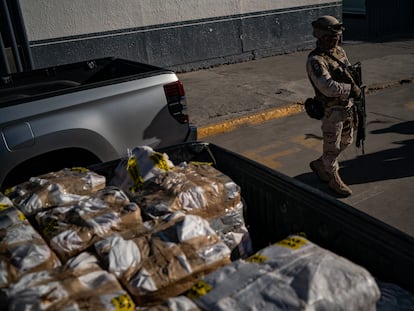US names veterinary drug, fentanyl mixture ‘emerging threat’
The tranquilizer xylazine is a depressant that can slow down users’ heart rates and breathing and cause skin ulcers and abscesses

The U.S. has named a veterinary tranquilizer as an “emerging threat” when it’s mixed with the powerful opioid fentanyl, clearing the way for more efforts to stop the spread of xylazine. The Office of National Drug Control Policy announced the designation Wednesday, the first time the office has used it since the category for fast-growing drug dangers was created in 2019.
Dr. Rahul Gupta, director of the drug policy office, said xylazine (pronounced ZAI’-luh-zeen) has become increasingly common in all regions of the country. It was detected in about 800 drug deaths in the U.S. in 2020 — most of them in the Northeast. By 2021, it was present in more than 3,000 fatalities —with the most in the South — according to a report last year from the Drug Enforcement Administration.
“We cannot ignore what we’re seeing,” Gupta said. “We must act and act now.”
Xylazine was approved for veterinary use in 1971. Sometimes known as “tranq,” it’s been showing up in supplies of illicit drugs used by humans in major quantities in only the last several years.
It’s believed to be added to other drugs to increase profits. Officials are trying to understand how much of it is diverted from veterinary uses and how much is made illicitly.
The drug causes breathing and heart rates to slow down, sometimes to deadly levels, and causes skin abscesses and ulcers that can require amputation. Withdrawal is also painful.
While it’s often used in conjunction with opioids, including fentanyl and related illicit lab-made drugs, it’s not an opioid. And there are no known antidotes.
Gupta said his office is requesting $11 million as part of its budget to develop a strategy to tackle the drug’s spread. Plans include developing an antidote, learning more about how it is introduced into illicit drug supplies so that can be disrupted, and looking into whether Congress should classify it as a controlled substance.
Gupta said it needs to be available for veterinary uses even amid crackdowns on the supply used by people. He also said systems to detect the drug and data about where it’s being used need to be improved.
The drug is part of an overdose crisis plaguing the U.S.
The U.S. Centers for Disease Control and Prevention estimates that more than 107,000 people died from overdoses in the 12 months that ended Nov. 30, 2022. Before 2020, the number of overdose deaths had never topped 100,000.
Most of the deaths were linked to fentanyl and other synthetic opioids. Like xylazine, they’re often added to other drugs — and users don’t always know they’re getting them.
Sign up for our weekly newsletter to get more English-language news coverage from EL PAÍS USA Edition
Tu suscripción se está usando en otro dispositivo
¿Quieres añadir otro usuario a tu suscripción?
Si continúas leyendo en este dispositivo, no se podrá leer en el otro.
FlechaTu suscripción se está usando en otro dispositivo y solo puedes acceder a EL PAÍS desde un dispositivo a la vez.
Si quieres compartir tu cuenta, cambia tu suscripción a la modalidad Premium, así podrás añadir otro usuario. Cada uno accederá con su propia cuenta de email, lo que os permitirá personalizar vuestra experiencia en EL PAÍS.
¿Tienes una suscripción de empresa? Accede aquí para contratar más cuentas.
En el caso de no saber quién está usando tu cuenta, te recomendamos cambiar tu contraseña aquí.
Si decides continuar compartiendo tu cuenta, este mensaje se mostrará en tu dispositivo y en el de la otra persona que está usando tu cuenta de forma indefinida, afectando a tu experiencia de lectura. Puedes consultar aquí los términos y condiciones de la suscripción digital.
More information
Archived In
Últimas noticias
Most viewed
- Sinaloa Cartel war is taking its toll on Los Chapitos
- Oona Chaplin: ‘I told James Cameron that I was living in a treehouse and starting a permaculture project with a friend’
- Reinhard Genzel, Nobel laureate in physics: ‘One-minute videos will never give you the truth’
- Why the price of coffee has skyrocketed: from Brazilian plantations to specialty coffee houses
- Silver prices are going crazy: This is what’s fueling the rally










































